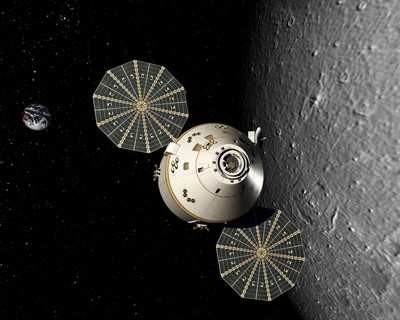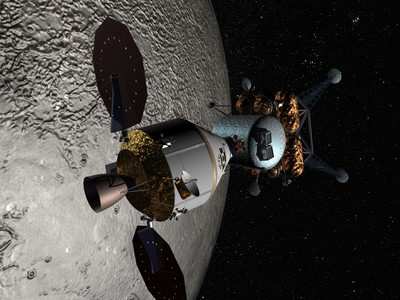Beats Out Boeing-Northrop Grumman Joint Venture
ANN REALTIME REPORTING: 08.31.06 1515 EDT: Lessons from the
past are guiding NASA's next step into the future, as the space
agency prepares to replace the space shuttle with an Apollo-style
vehicle for human explorers -- and moments ago, NASA
named Lockheed Martin as the company to build its
next-generation spacecraft.

Orion will succeed the space shuttle as NASA's primary vehicle
for human space exploration. Orion's first flight with astronauts
onboard is planned for no later than 2014 to the International
Space Station. Its first flight to the moon is planned for no later
than 2020.
 Lockheed Martin released
images of its CEV design, with the most obvious change from earlier
renderings being the circular solar panels. The capsule and service
module arrangements are also somewhat flatter than in past
pictures.
Lockheed Martin released
images of its CEV design, with the most obvious change from earlier
renderings being the circular solar panels. The capsule and service
module arrangements are also somewhat flatter than in past
pictures.
The vehicle will be assembled at New Orleans' Michoud Assembly
Facility, that currently assembles external fuel tanks for the
space shuttle.
The last NASA contract awarded to Lockheed Martin for a manned
spacecraft was in 1996, for the X-33 spaceplace that was intended
to replace the space shuttle. After $912 million spent on the
program, NASA cancelled the project due to ongoing technical
problems.
Orion Background
NASA states that versatility will be Orion's trademark. It is
being designed to fly to the moon, but could also be used to
service the International Space Station in low-Earth orbit.
"Our intent is to keep the destination focusing the design but
we are not excluding the possibility of using Orion for other
things, such as de-orbiting the Hubble Space Telescope in the 2020s
or making a trek to an asteroid," said Jeff Hanley, who manages the
Constellation Program from the Johnson Space Center in Houston.

Orion is the primary payload of the Ares I rocket's 25-ton
mission, designed to reach low-Earth orbit for rendezvous with the
International Space Station or an Earth Departure Stage and lunar
lander.
Orion improves on the best features of Project Apollo and the
Space Shuttle Program, increasing the likelihood of success. "Going
with known technology and known solutions lowers the risk" said
Neil Woodward, director of the integration office in the
Exploration Systems Mission Directorate at NASA Headquarters in
Washington.

"Although Orion borrows its shape and aerodynamic performance
from Apollo, the new capsule's updated computers, electronics, life
support, propulsion and heat protection systems represent a marked
improvement over legacy systems. We're pushing the technological
edge, but only where it makes sense," says Woodward.
Unlike the winged space shuttle orbiter, which is mounted beside
its external fuel tank and boosters for liftoff... Orion will be
placed on top of its booster to protect it from ice, foam, and
other launch system debris during ascent. Placing the spacecraft on
top of the launch vehicle also allows the addition of an abort
system that can separate capsule and crew from the booster in an
emergency.

Among the most obvious improvements is the command module's
size. Measuring 16.5 feet in diameter, Orion will have more than
2.5 times the interior volume of the three-seat Apollo capsules
that carried astronaut crews to the moon for missions lasting only
several hours to several days in the late 1960s and early 1970s.
Orion will be crucial for developing a sustained human presence on
the moon. It will be able to carry four astronauts to the moon and
support missions of up to six months.

"You don't get the chance to build a new human spacecraft every
day," said Skip Hatfield, the Orion project manager in Houston.
"This is a wonderful opportunity for NASA to learn from the things
we've done in the past, take the best of those activities, and
blend them together using the latest methods of manufacturing and
management to make a system that will enable us to go out and
explore beyond low-Earth orbit."
 Unfortunate... ANN/SportPlane Resource Guide Adds To Cautionary Advisories
Unfortunate... ANN/SportPlane Resource Guide Adds To Cautionary Advisories ANN FAQ: Turn On Post Notifications
ANN FAQ: Turn On Post Notifications ANN's Daily Aero-Term (04.29.24): Visual Approach Slope Indicator (VASI)
ANN's Daily Aero-Term (04.29.24): Visual Approach Slope Indicator (VASI) ANN's Daily Aero-Term (04.28.24): Airport Marking Aids
ANN's Daily Aero-Term (04.28.24): Airport Marking Aids ANN's Daily Aero-Linx (04.28.24)
ANN's Daily Aero-Linx (04.28.24)








